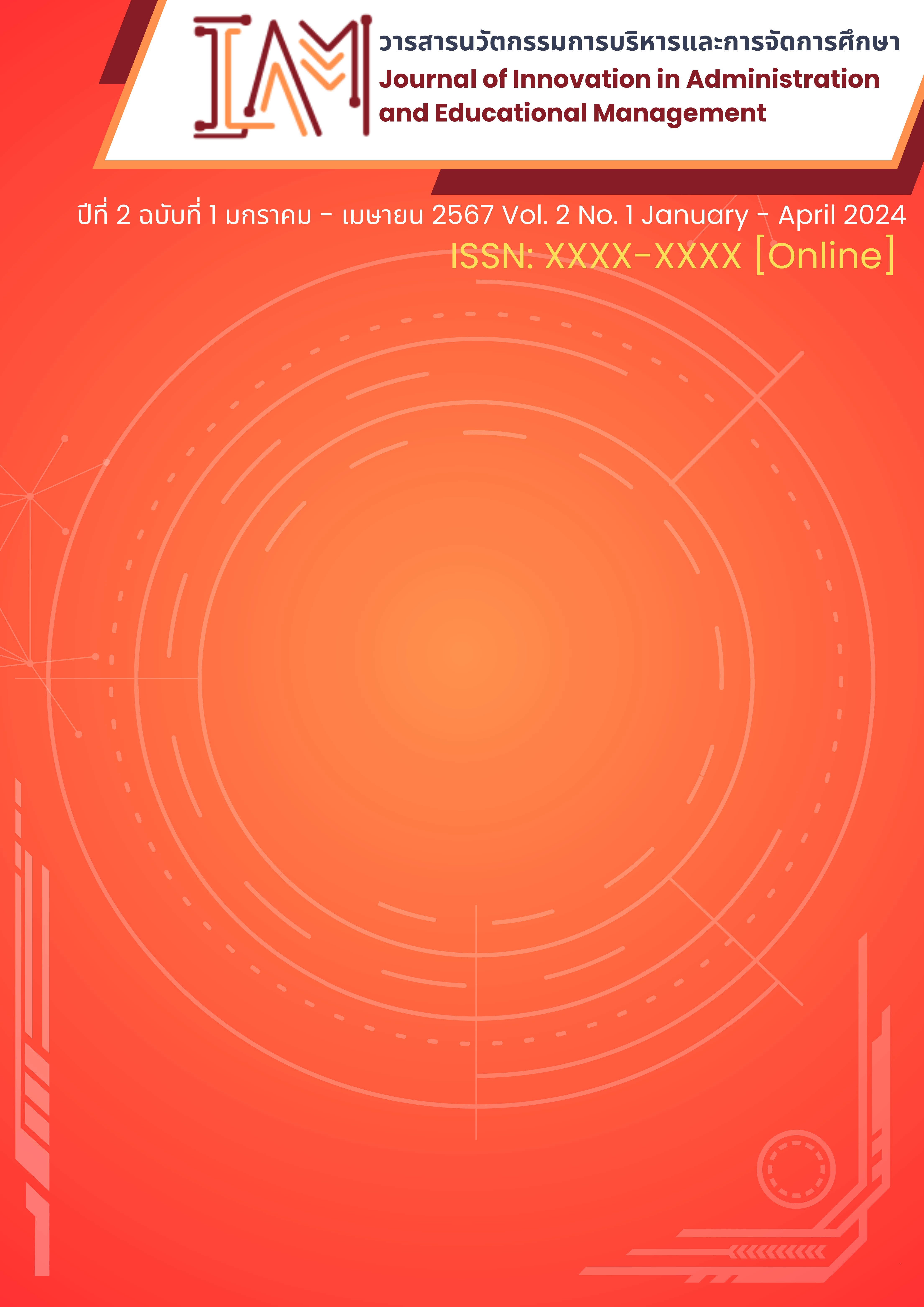การพัฒนากลยุทธ์หลักสูตรอาชีวศึกษาเชิงผลลัพธ์ในจังหวัดปัตตานี เพื่อยกระดับสมรรถนะวิชาชีพและสร้างศักยภาพสู่การเป็นผู้ประกอบการ
คำสำคัญ:
กลยุทธ์การพัฒนาหลักสูตรเน้นผลลัพธ์, หลักสูตรอาชีวศึกษา, การเป็นผู้ประกอบการบทคัดย่อ
การศึกษานี้มีวัตถุประสงค์เพื่อวิเคราะห์ปัจจัยที่ส่งผลต่อการพัฒนากลยุทธ์หลักสูตรอาชีวศึกษาที่เน้นผลลัพธ์ในจังหวัดปัตตานี ซึ่งมุ่งเสริมสร้างสมรรถนะวิชาชีพและเพิ่มศักยภาพในการเป็นผู้ประกอบการ รวมถึงศึกษารูปแบบการพัฒนากลยุทธ์หลักสูตรที่มุ่งเน้นผลลัพธ์เพื่อยกระดับทักษะวิชาชีพการวิจัยใช้วิธีการสัมภาษณ์เชิงลึก (In-depth Interviews) กับผู้บริหาร ครู และผู้ประกอบการ เพื่อรวบรวมข้อมูลเชิงคุณภาพเกี่ยวกับการพัฒนาหลักสูตรและความท้าทายที่พบ นอกจากนี้ ยังมีการจัดการสนทนากลุ่ม (Focus Group Discussion) กับนักเรียนและครู เพื่อหารือเกี่ยวกับประสบการณ์การเรียนรู้และข้อเสนอแนะในการปรับปรุงหลักสูตร ผลการศึกษาพบว่าการพัฒนาหลักสูตรอาชีวศึกษาเชิงผลลัพธ์ในจังหวัดปัตตานีมีความซับซ้อน โดยมีปัจจัยที่มีอิทธิพลต่อการพัฒนาหลักสูตรแบ่งออกเป็นจุดแข็ง เช่น ความรู้และประสบการณ์ของครู และความสามารถในการปรับปรุงหลักสูตร และจุดอ่อน เช่น การขาดการฝึกอบรมสำหรับครู และการขาดความร่วมมือกับผู้มีส่วนได้ส่วนเสีย นอกจากนี้ ยังมีโอกาสจากตลาดแรงงานที่มีความต้องการสูงและนโยบายสนับสนุนการพัฒนา ในขณะที่อุปสรรคได้แก่ การเปลี่ยนแปลงของตลาดแรงงานและข้อจำกัดด้านโครงสร้างพื้นฐานกลยุทธ์ในการพัฒนาหลักสูตรที่เสนอ ได้แก่ การพัฒนาหลักสูตรที่ยั่งยืนตามแนวทาง Outcome-Based Education (OBE) การพัฒนาทักษะของครู และการเพิ่มความยืดหยุ่นของหลักสูตร เพื่อให้สามารถตอบสนองต่อความท้าทายและบริบทเฉพาะของพื้นที่จังหวัดปัตตานี
Downloads
เอกสารอ้างอิง
พฤกษ์ เสาวคนธ์. (2563). การพัฒนาหลักสูตรอาชีวศึกษาในเขตพื้นที่จังหวัดชายแดนภาคใต้เพื่อส่งเสริมสมรรถนะการเป็นผู้ประกอบการ. วารสารการศึกษาไทย, 14(2), 88-104.
Awan, A. G., & Javed, B. (2018). Impact of outcome-based education on students' learning: A study on higher education. Journal of Educational Research and Reviews, 6(1), 12-23.
Awan, A. G., & Javed, B. (2018). The impact of outcome-based education on vocational curriculum development: A case study of developing economies. Journal of Education and Practice, 9(7), 45-57.
Awan, U., & Javed, B. (2018). The role of knowledge management in achieving effective organizational performance: A case study of private and public sector organizations. International Journal of Management, 37(1), 52-62.
Beauchamp, G. A. (1981). Curriculum theory: Meaning, development, and use. Wilbur Press.
Billett, S. (2011). Vocational education: Purposes, traditions, and prospects. Springer.
Biggs, J., & Tang, C. (2011). Teaching for quality learning at university: What the student does. 4th ed.. McGraw-Hill Education.
Choo, S. L., & Wong, C. H. (2020). Vocational education: Aligning curriculum with labor market needs in emerging economies. International Journal of Educational Development, 71, 102142.
Choo, S. Y., & Wong, K. L. (2020). The gap between vocational education curriculum and industry needs: Case of Southeast Asia. Journal of Vocational Education and Training, 72(4), 523-540.
Gupta, V., Chauhan, S., Paul, J., & Jaiswal, M. P. (2020). Entrepreneurial intentions and start-ups: Are women paving the way for a more balanced approach? A study of India and China. International Journal of Entrepreneurial Behavior & Research, 26(4), 835-857.
Hanushek, E. A. (2011). The economic value of higher teacher quality. Economics of Education Review, 30(3), 466-479.
Harden, R. M., & Sowden, S. (2016). Outcome-based education: The future of education in medicine and beyond. Routledge.
Korkmaz, H., & Yalcin, F. (2019). Alignment of vocational education and training with industry requirements: The case of Southeast Asia. Educational Research and Reviews, 14(5), 189-198.
Korkmaz, M., & Yalcin, H. (2019). SWOT analysis in vocational education: A new approach to curriculum development. Journal of Technical Education, 22(3), 89-103.
McKnight, K., O'Malley, K., Ruzic, R., Horsley, M. K., Franey, J. J., & Bassett, K. (2016). Teaching in a digital age: How educators use technology to improve student learning. Journal of Research on Technology in Education, 48(3), 194-211.
Norris, N., Davis, P., Yee, W. C., & Harris, R. (2015). What is successful teaching? British Educational Research Journal, 41(2), 301-318.
Ramsden, P. (2020). Learning to teach in higher education 3rd ed.. Routledge.
Sánchez, J. A., & Otero, C. P. (2020). Competency-based curriculum in vocational education: Enhancing employability. Journal of Employment and Skills Development, 48(3), 110-122.
Sánchez, J. M., & Otero, M. (2020). Regional labor market demand and its influence on vocational education curriculum design. Education Economics Review, 45, 154-165.
Sánchez, M. T., & Otero, M. M. (2020). Strategic approaches to integrating local context into vocational education programs. International Journal of Educational Research, 99, 101503.
Spady, W. G. (1994). Outcome-based education: Critical issues and answers. American Association of School Administrators.
Taba, H. (1962). Curriculum development: Theory and practice. Harcourt Brace.
Tyler, R. W. (1949). Basic principles of curriculum and instruction. University of Chicago Press.
Yang, J., & Ma, J. (2015). Enhancing vocational education: Linking entrepreneurship skills to market needs. Asian Journal of Education and Training, 1(2), 59-67.
ดาวน์โหลด
เผยแพร่แล้ว
รูปแบบการอ้างอิง
ฉบับ
ประเภทบทความ
สัญญาอนุญาต

อนุญาตภายใต้เงื่อนไข Creative Commons Attribution-NonCommercial-NoDerivatives 4.0 International License.






